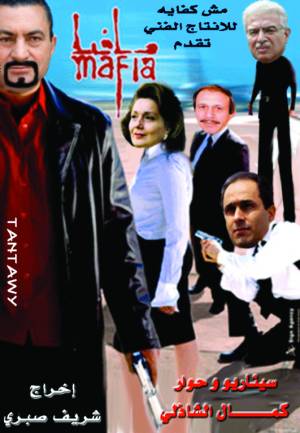TACTIC 5: VIDEO
PROVOKE A SMILE
just add humour
download this tactic card (pdf 672kb)
watch the full video
THIS TACTIC IS GOOD FOR REACHING OUT TO DIVERSE AUDIENCES AND FOR ENCOURAGING PEOPLE TO SPREAD YOUR MESSAGES
EXAMPLES FROM THE VIDEO
|
FREE EGYPT YOUTUBE CHANNEL |
Artists and Advocates in Egypt Egyptians remixed images of President Mubarak into popular film posters. The images spread quickly on the internet. The humour in the posters took away from Mubarak’s mystique, and allowed people who did not think of themselves as activists to stand up to their President, even in a joking way.
TOOLS USED: Digital photo editing software, Facebook, blogs, email, YouTube.
LINKS TO LEARN MORE: |
|
|
Asia Pacific Network of Sex Workers Responding to laws that discriminate against them, sex workers produced satirical karaoke videos using prominent political figures as characters. By screening these videos at bars, clubs, and parties, sex workers educated each other in their own workplaces. The videos were also shown at advocacy meetings and conferences to expose policy-makers to sex worker communities and issues. One video received nearly 10,000 views online.
TOOLS USED: Digital video cameras, video editing software, blip.tv, YouTube, blogs.
LINKS TO LEARN MORE: |
- "Give Lukashenko his own Lu-net!"
Advocates in Belarus
Belarusians created a group of websites they called LuNet, in mock honour of President Alexander Lukashenko’s birthday, after he promised to increase internet censorship. Two of the LuNet sites were called LuJournal and LuTube, instead of LiveJournal and YouTube, and they were packed with government propaganda amid ironic posts. This drew attention to internet censorship and the detention of bloggers for political purposes.
TOOLS USED: Blogs, LiveJournal, YouTube.
LINKS TO LEARN MORE:
TACTIC 5: PLAN YOUR ACTION
PROVOKE A SMILE
just add humour
download this tactic card (pdf 672kb)

WWW.TANTAWY.TK
Plan your action
- Even when using humour, it is best to match your campaign's tactics to the strengths of the people you want to mobilise. The Egyptian poster campaign took advantage of young people’s knowledge of how to edit images together and their desire to spread funny images on the internet.
- With the LuNet actions, no one person or campaign was in charge. This led to many more people being able to participate in making and sharing parody images and websites, and decentralised the image-making so that no one person bore all the risk of satirising a powerful figure.
- The kinds of messages you can communicate in an informal setting – like a karaoke bar or pub – can be very powerful in reducing people’s fear and getting them to feel included in the issue. The same is true for basing your action in places where people socialise online.
- Having a good time and getting social recognition can be an effective motivator. As part of remixing President Mubarak into movie posters or creating President Lukashenko’s internet, people left comments for each other on their social network site profiles, blogs, and video and photo sharing websites with positive feedback on each new image they posted. This informal reward for being part of a campaign can keep people invested in even a very challenging or serious issue.
Do it yourselfAsk
- Will you be asking people to make things – images, videos, cartoons – as part of your campaign? How will you share them online and what do you need to do protect people’s anonymity?
- It can be difficult to keep track of all the images and videos people make as part of a humour or parody campaign. How will you archive people's contributions?
- How will you balance respect for the people involved in the issues with the satirical content? How much can you joke and still be trustworthy to people?
- Are there serious consequences in the regions you are working in for those who criticise the government and others in positions of power?
- Will you directly approach the media to publicise your actions and your campaign?
- What relationship does your spontaneous or parody campaign have with rights organisations doing more 'traditional' campaigning? Should you try to connect with those organisations in any way?
- How will you bridge the gap between people's online posts with offline actions?
Different ways you can do this
- If you can’t use Twitter or another service to send messages to a group to coordinate an action quickly, or you need to keep communication more private, send text messages directly to your supporters’ mobile phones. Sex workers have done this to create a flash mob of open red umbrellas – their campaign symbol – in front of public administration buildings with just a few hours notice.
- You can spread messages using mobile phone ringtones. After the 2004 election in the Philippines, a ringtone was made which used a recorded phone conversation with the President that appeared to provide evidence of vote-rigging, and this was re-mixed with music. It became one of the world’s most downloaded ringtones. One organisation provided the supposed original phone recording and invited people to create their own ringtone remixes.
- Use remixed or parody images that have been posted to blogs and social network sites for your campaign by adapting them to create street art, posters, and handbills.
- In addition to creating parody websites like LuNet, you can make parody news websites that critique the censored media, and also give practical information and facts in a clever or surprising way.
|
FEATURED TOOL Mix your own ringtone and raise awareness using humour If you want to draw attention to comments made by a politician or public figure, you can edit these from a radio or television broadcast and re-mix this with music to make your own ringtone. Audacity is a free and open source software that will help you to do this. It is easy to use and it allows you to make new and mix multiple recordings together. For detailed instructions on how to make your own ringtone see the Audacity Wiki. You can share your ringtone on your website and on popular ringtone sharing sites like phonezoo to help them spread further. |
TIPS ALAA, OPEN SOURCE DEVELOPER AND TECHNOLOGIST, ON HUMOUR AND VIRAL MESSAGING: "In Egypt we have had a dictatorial regime for 25 years. If I get a joke about my President and forward it to 10 of my friends and each of them forwards it their friends, the joke might get modified on the way, but it is spreading virally and very quickly."
ADVOCATE IN BELARUS, ON THE LIMITATIONS OF THE INTERNET: "The flash mobs in Belarus weren’t very popular in all regions, because they depended on the active online community, and internet penetration wasn’t that strong outside of the capital back then. But they were important because they showed fresh and creative thinking, and brought together a lot of the young people who likely never before participated in any political or civic actions."
SAMI GHARBIA, GLOBAL VOICES ON CHALLENGING POWER: "Humour is the first step to break taboos and to fears. Making people laugh about dangerous stuff like dictatorship, repression, censorship is a first weapon against those fears…without beating fear you can not make any change. So humour is very effective." |
TACTIC 5: CASE STUDY
PROVOKE A SMILE
just add humour
download this tactic card (pdf 672kb)

Case Study
| TITLE: WHO: WHERE: WEBSITE: |
Flash mobs in Belarus Belarusian advocates Public squares in Belarus, 2006 Belarusian Flash Mob Community |
DESCRIPTION
In a response to the contested Presidential elections in Belarus in 2006, advocates used the internet to organise gatherings to oppose President Lukashenko's administration. The gatherings they organised were 'flash mobs' – brief, sudden actions performed by a large group of people who assemble in a public place before quickly dispersing. These flash mobs were mostly organised a day or two before they happened through websites, blogs, SMS, and online chat programmes. They had special significance in Belarus because unauthorised group public actions are prohibited by the government. At one flash mob, 40 to 50 people entered a public square eating ice creams, humourously drawing attention to the restrictions on the right to public gatherings. While the young people involved had done nothing except eat ice cream together, several were arrested. Others took photographs of the arrests and these circulated widely on LiveJournal and other websites. The flash mob received significant international media attention. Zhenya Mantsevich, a journalist and blogger in Belarus, says, "The result of the flash mobs was that many people saw how cruel and stupid our authorities can be, if they detain even people eating ice cream. People saw that something is wrong in our society."
| TOOLS USED: | Both personal and community pages on LiveJournal. ICQ (chat programme). Text messages on mobile phones. |
| REACH: | 12 flash mobs as a reaction to the 2006 elections, with 100-200 people at the most well-attended flash mobs. Most participants were from Minsk. |
| RESOURCES: | Internet access and mobile phone access for the people who gathered. |
| TIME: | Anywhere from a few hours to a few days to coordinate enough people for the flash mob, but not more than that, as word could reach authorities if too much time is taken to announce the gathering. |
LEVEL Of DIFFICULTY: 1
COST: Free, with small individual cost of sending text messages via SMS.
LINKS TO LEARN MORE:


